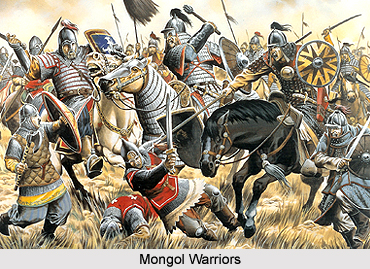 Kashmir was invaded by a Mongol force after 1235. An administrative governor known as darughachi was appointed when Kashmir came under the Mongolian dependency. During that period Otochi, a Buddhist master native of Kashmir along with his brother Namo came to the court of Ogedei.
Kashmir was invaded by a Mongol force after 1235. An administrative governor known as darughachi was appointed when Kashmir came under the Mongolian dependency. During that period Otochi, a Buddhist master native of Kashmir along with his brother Namo came to the court of Ogedei.
At the same time another Mongol army under general Pakchak invaded Peshawar and overpowered the tribal forces that had once abandoned Jalal ad-Din, the Delhi prince. These tribal army, deemed to be a threat to the Mongols, were chiefly Khiljis who had migrated to Multan. The Delhi Sultanate appointed them in their army. The Mongol forces launched a surprise attack on the Indus Valley in 1241 and annexed Lahore. In the battle General Dayir got killed. Before retreating from the Delhi Sultanate the Mongols forces under Munggetu completely plundered the town of Lahore on December 30, 1241. The Great Khan Ogedei died during that time.
In 1254-1255 the Kashmiris revolted back. Mongke Khan appointed as the Great Khan in 1251 selected Sali and Takudar, his generals, for replacing the court. He then appointed Otochi, the Buddhist master, as the darugachi of Kashmir. The newly chosen was however, killed by the Kashmiri king at Srinagar. When Kashmir was invaded the king was killed that concluded the rebellion. As a result the Mongol Empire dominated the country for several years.
Jalal al-Din Masud, the prince of Delhi, paid a visit to Karakorum, the Mongol capital, in 1248 to receive the help of Mongke Khan in usurping the throne from his elder brother. A grand ceremony was held when Mongke was being crowned as the Great Khan. The ceremony was attended by Jalal al-Din Masud who asked for assistance from Mongke to fulfil his mission. Mongke appointed Sali for the mission who repeatedly attacked on Multan and Lahore. The Mongols were assisted in their conflict by the Sham al-Din Muhammad Kart, the ruling prince of Heart. Soon Jalal al-Din was established as the client ruler of Kujah, Lahore and Sodra.
The governor of Sindh in 1257 offered his whole province to the brother of Mongke, Hulagu Khan, to seek protection from the Mongols. Hulagu sent a huge force to Sindh under Sali Bahadur. During 1257-1258 Sali Noyan demolished all the fortifications of Multan, entering into the city of Sind.
Hulagu however, refused to launch any invasion on the Delhi Sultanate. Their diplomatic communications helped to augment their wish for peace. Thus, extensive Mongol attacks on India ended and the Delhi Sultans became engaged in gaining back the frontier towns such as Lahore, Multan and Uch.






































